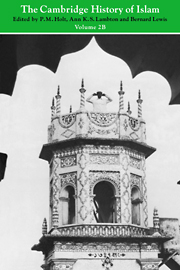Book contents
- Frontmatter
- Introduction
- PART VIII ISLAMIC SOCIETY AND CIVILIZATION
- 1 THE GEOGRAPHICAL SETTING
- 2 THE SOURCES OF ISLAMIC CIVILIZATION
- 3 ECONOMY, SOCIETY, INSTITUTIONS
- 4 LAW AND JUSTICE
- 5 RELIGION AND CULTURE
- 6 MYSTICISM
- 7 REVIVAL AND REFORM IN ISLAM
- 8 LITERATURE
- (a) ARABIC LITERATURE
- (b) PERSIAN LITERATURE
- (c) TURKISH LITERATURE
- (d) URDU LITERATURE
- 9 ART AND ARCHITECTURE
- 10 SCIENCE
- 11 PHILOSOPHY
- 12 WARFARE
- 13 THE TRANSMISSION OF LEARNING AND LITERARY INFLUENCES TO WESTERN EUROPEo
- Dynastic List
- Bibliography
- Glossary
- Index
- References
(b) - PERSIAN LITERATURE
from 8 - LITERATURE
Published online by Cambridge University Press: 28 March 2008
- Frontmatter
- Introduction
- PART VIII ISLAMIC SOCIETY AND CIVILIZATION
- 1 THE GEOGRAPHICAL SETTING
- 2 THE SOURCES OF ISLAMIC CIVILIZATION
- 3 ECONOMY, SOCIETY, INSTITUTIONS
- 4 LAW AND JUSTICE
- 5 RELIGION AND CULTURE
- 6 MYSTICISM
- 7 REVIVAL AND REFORM IN ISLAM
- 8 LITERATURE
- (a) ARABIC LITERATURE
- (b) PERSIAN LITERATURE
- (c) TURKISH LITERATURE
- (d) URDU LITERATURE
- 9 ART AND ARCHITECTURE
- 10 SCIENCE
- 11 PHILOSOPHY
- 12 WARFARE
- 13 THE TRANSMISSION OF LEARNING AND LITERARY INFLUENCES TO WESTERN EUROPEo
- Dynastic List
- Bibliography
- Glossary
- Index
- References
Summary
Of the countries falling completely under Arab rule in the early days of Islam, Persia was the only one which succeeded in preserving her national language, thereby maintaining a separate identity within the Islamic world. The language of the country, however, did not remain static, but gradually adjusted itself to the profound changes which the advent of Islam caused in Persian society. When after two hundred years of Arab rule Persian emerged again as a literary medium, it had assumed a fresh colouring, distinct from that of the Middle Persian of the Sasanian era. It had adopted a simpler morphology and had shed most of the words with Zoroastrian connotations, acquiring instead a considerable Arabic vocabulary.
In imperial Persia secular literature had been of a courtly character, and both its form and content reflected the tastes and interests of the kings and nobles who were its chief patrons. The destruction of Sasanian power brought to an end this system of patronage, and in the subsequent period of disruption, change and readjustment, Muslim Persians began to apply their talents to the enrichment of Arabic writing. Their contributions did much to develop Arabic literature into a diverse and truly living structure.
In the third/ninth century, however, with the weakening of the central power of the caliphs in Baghdād and the establishment of autonomous dynasties on Persian soil, the way was once again open for the emergence of a national literature.
Keywords
- Type
- Chapter
- Information
- The Cambridge History of Islam , pp. 671 - 682Publisher: Cambridge University PressPrint publication year: 1977

